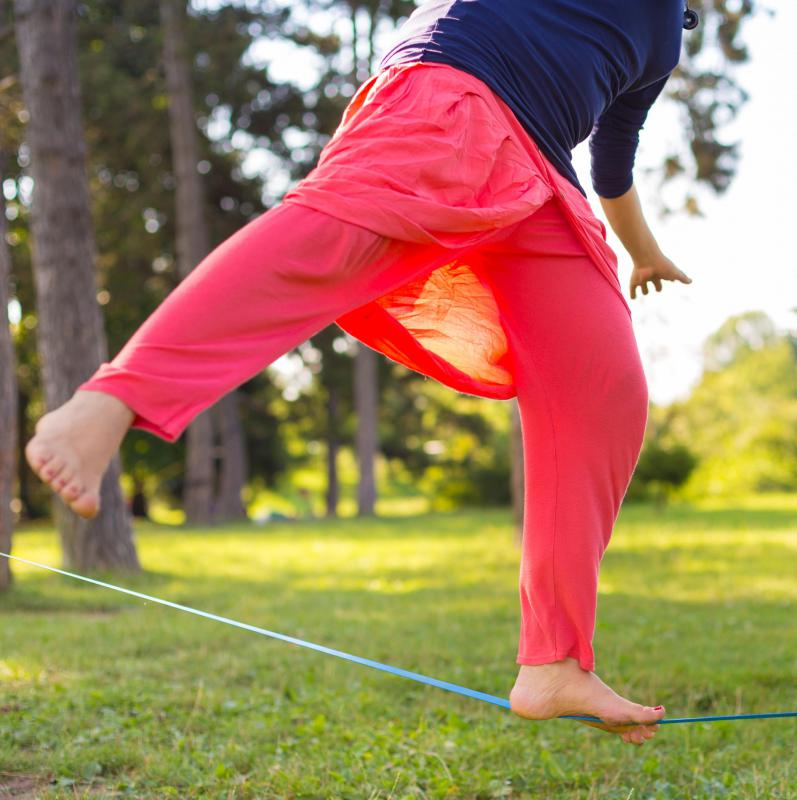At WiseGEEK, we're committed to delivering accurate, trustworthy information. Our expert-authored content is rigorously fact-checked and sourced from credible authorities. Discover how we uphold the highest standards in providing you with reliable knowledge.
What are the Different Types of Balance Exercise Equipment?
There are several types of balance exercise equipment available through fitness retailers for health club or home use. These can be purchased via websites as well as in sporting-goods stores. Options include but are not limited to inflatable stability balls, the BOSU® ball, wobble and balance boards, and balance disks, with each type of balance exercise equipment offering a different challenge and degree of difficulty. This equipment is intended to be incorporated into one’s fitness routine to work the body's core muscles, which include the muscles of the abdominals, low back, hips, and pelvic floor.
The piece of balance exercise equipment that offers users the most variety is the stability ball, which, because it can roll around, creates an unstable environment in which to perform exercises. Available in several sizes to correspond with the exerciser’s height, the stability ball is an inflatable rubber ball that averages about 21.6 inches (55 cm) in diameter. With exercise options for impaired, novice, and advanced exercisers alike, one can use the ball to increase the challenge on core muscles by sitting on, leaning against, lying on top of, propping one’s feet on, or even kneeling on the ball. Unlike the other forms of balance equipment, the stability ball can also be used to perform stretches.

A similar option for balance training is the BOSU® ball, appropriate for all levels of training and widely available in big-box stores and online. The BOSU® is a half-sphere, with a rounded rubber surface on one side and a flat surface on the other. When the rounded surface is face-up, one can stand, kneel, or lie on the ball and perform exercises without the instability of the stability ball, whereas when the flat surface is face-up, users have the option of standing on the BOSU® for 360 degrees of instability. It can also be used flat-side-up to perform exercises like push-ups.

Another type of balance exercise equipment that offers exercisers a range of options is the balance board. The balance board is an elliptical platform perched upon four legs a few inches off the floor that can be adjusted for increased or decreased stability. It is mostly intended to be stood upon while performing exercises with dumbbells or tubing, but it can also be used for bodyweight exercises like lunges and push-ups. The difficulty level of the balance board is relatively low.

Slightly more challenging to one’s stability is a type of balance exercise equipment known as the balance disk or cushion. Typically sold in pairs, the balance disk is an inflatable cushion roughly the size of a dinner plate that is intended to be stood upon, one foot on each, while performing squats and various dumbbell, barbell, or cable exercises. It offers users less variety than the previous three forms of equipment and, as it is considered more difficult to stand upon than the balance board, may not be recommended for novice exercisers.

Among the most difficult pieces of balance exercise equipment available is the wobble board. Sold in square and round versions, the wobble board features a flat and often wooden board perched atop either a narrow wedge or a rounded base. The square board is commonly 16 inches (40.64 cm) across, features a long, narrow base, and is intended for training side-to-side or front-to-back movements only. Similar in size, the round board has round base that is significantly smaller than the platform and is designed for 360 degrees of instability. It is recommended for advanced exercisers only.
AS FEATURED ON:
AS FEATURED ON:















Discuss this Article
Post your comments